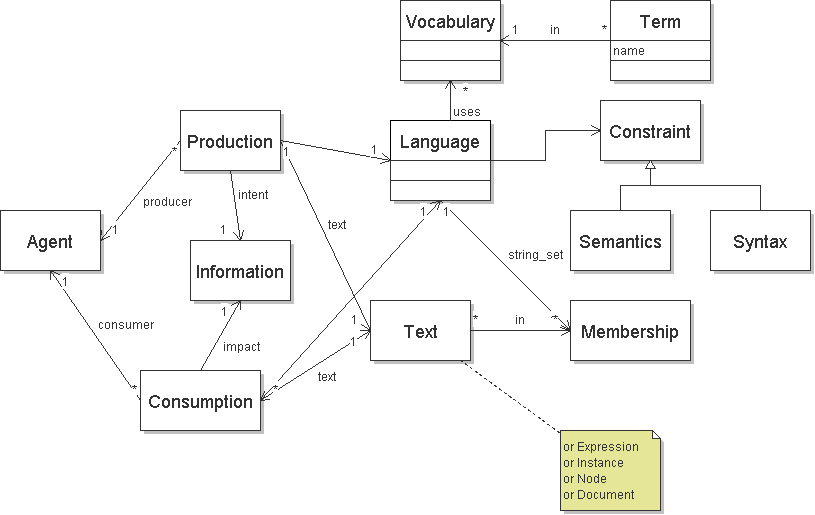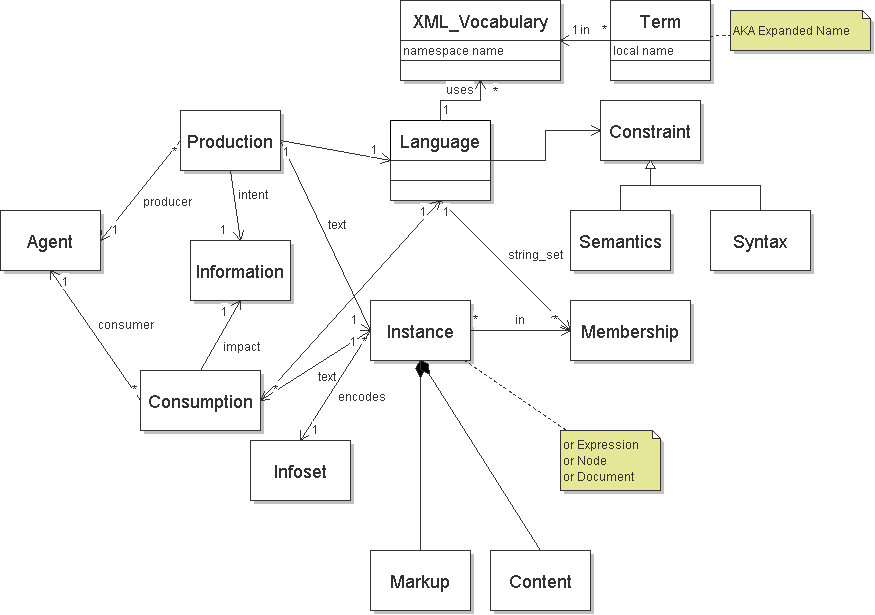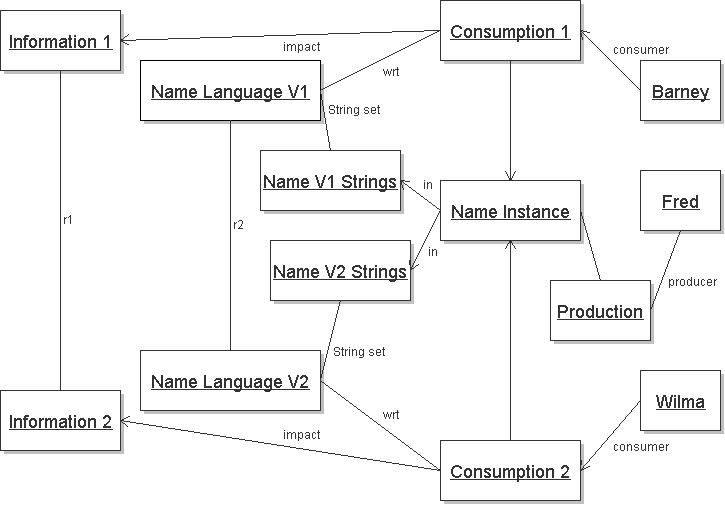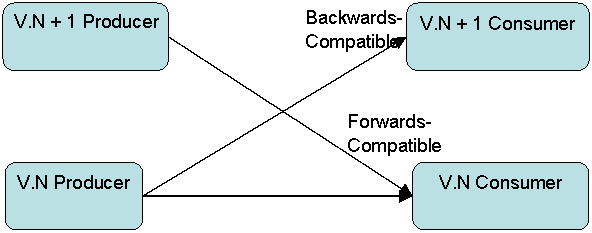XML is designed for the creation of languages using a
self-describing system of markup: elements and attributes, or components.
The inevitable evolution of these languages, by adding, deleting, and
changing syntax or semantics of parts is called versioning. Making versioning work in
practice is one of the most difficult problems in computing. Arguably,
the Web rose dramatically in popularity because evolution and
versioning were built into HTML and HTTP. Both systems provide
explicit extensibility points and rules for understanding extensions
that enable their decentralized extension and versioning.
This finding describes general problems and techniques in evolving systems in compatible and incompatible ways. These
techniques are designed to allow compatible changes with or without
schema propagation. A number of questions, design patterns and rules
are discussed with a focus towards enabling versioning in XML
vocabularies, making use of XML Namespaces and XML Schema constructs.
This includes not only general rules, but also rules for working with
languages that provide an extensible container model, notably
SOAP.
This finding does not discuss, except
in passing, techniques and strategies that involve fundamental changes
to current schema validation systems.
1.1 Terminology
The terminology for describing languages, namespaces, constraints, evolvability etc. follows. Let us consider an example. Two or more systems need to exchange name information. Names may not be the perfect choice of example because of internationalization reasons, but it resonates strongly with a very large audience. The Name language is created to be exchanged. [Definition: A producer is an agent that creates text. ] Continuing our example, Fred is a producer of Name language text.
[Definition: A Production is the creation of text.]. A producer produces text for the intent of conveying information. When Fred does the actual creation of the text, that is a production. [Definition: A consumer
is an agent that consumes text.] We will use Barney and Wilma as consumers of text.
[Definition: A Consumption is the processing of text of a language.] Wilma and Barney consume the text separately from each other, each of these being a consumption event. A consumer is impacted by the instance that it consumes. That is, it interprets that instance and bases future processing, in part, on the information that it believes was present in that instance. Text can be consumed many times, by many consumers, and have many different impacts.
Generally, a language has one or more vocabularies that each may have multiple terms. Formally, [Definition: a language is an identifiable set of vocabulary terms with defined syntactic and semantic constraints. ] By language, we mean the set of text that are members of that language and used by a particular application. [Definition: A vocabulary is a set of terms]. The Name language consists of 3 terms: name, given, family. In order to identify the terms in the Name language in XML, a namespace is assigned to the terms. Other examples include the elements and attributes of XHTML 1.0 or the names of built-in functions in XPath 2.0. The Name language could consist of terms from other vocabularies, such as Dublin Core or UBL. These terms each have their own namespaces, illustrating that a language can comprise vocabularies from multiple namespaces.
The name language takes the 3 terms and specifies the constraints: that a name consists of a given and a family. [Definition: A language has a set of constraints that apply to the vocabulary terms in the language. ] These constraints can be defined in machine processable syntactic constraint languages such as XML Schema, human readable textual descriptions such as HTML descriptions, or are embodied in software. Languages may or may not be defined by a schema in any particular schema language. The constraints on a language determine the strings that qualify for membership in the language. There is a close relationship between terms and strings that we have not chosen to call out in an effort to keep the terminology as minimal as possible. From a text or string perspective, a language is the set of strings that are part of the language. Vocabulary terms contribute to the set of strings, but they are not the only source of characters to the set of strings in a given language. The language strings may include characters outside of terms, such as punctuation. One reason for additional characters are to distinguish or separate terms, such as whitespace and markup. Languages can also relate to the interpretation of a given string, that is 2 languages may have the exact same string but different meanings. We have chosen to elide that notion from our terminology
<name>
<given>Dave</given>
<family>Orchard</family>
</name>
name="Dave Orchard"
<span class="fn">Dave Orchard</span>
urn:nameschem:given:Dave:family:Orchard
In general, the intended meaning of a vocabulary term is scoped by the language in which the term is found. However, there is some expectation that terms drawn from a given vocabulary will have a consistent meaning across all languages in which they are used. Confusion often arises when terms have inconsistent meaning across language. The Name terms might be used in other languages, but it is generally expected that they will still be "the same" in some meaningful sense.
[Definition: Text is a specific, discrete sequence of characters]. Given that there are constraints on a language, any particular text may or may not have membership in a language. Indeed, a particular string of characters may be a member of many languages, and there may be many different strings of characters that are members of a given language. The text of the language are the units of exchange. Documents are texts of a language.
These terms and their relationships are shown below

There are many different systems for exchanging texts in languages, such as SQL, Java, XML, ECMAScript, C#. We will briefly describe some key refinements to our lexicon for XML. An XML language has a vocabulary that may use terms from one or more XML Namespaces (or none), each of which has a namespace name.
[Definition: An XML language is an identifiable set of vocabulary terms with defined XML syntactic and semantic constraints. ] By XML language, we mean the set of elements and attributes, or instances, used by a particular application. The Name language - consisting of name, given, family - has a namespace is assigned to the terms. We use the prefix "namens" to refer to that namespace. The Name language could consist of terms from other vocabularies, such as Dublin Core or UBL. These terms each have their own namespaces, illustrating that a language can comprise vocabularies from multiple namespaces. An XML Namespace is a convenient container for collecting terms
that are intended to be used together within a language or across languages. It provides a mechanism for creating globally unique names.
We shall use the term instance when speaking of sequences of characters (aka text) in XML. [Definition: An instance is a specific, discrete sequence of terms]. Documents are instances of a language. In XML, they must have a root element. A name document might be a name element as the root element. Alternatively, the name vocabulary may be used by a language such as purchase orders. The purchase order documents may contain name elements. Thus instances of a language are always part of a document and may be the entire document. XML instances (and all other instances of markup languages) consist of markup and content. In the name example, the given and family elements including the end markers are the markup. The values between the start and end markers are the content. An instance has an information model. There are a variety of data models within and without the W3C, and the one standardized by the W3C is the XML infoset.
The XML related terms and their relationships are shown below

A stylesheet processor is a
consumer of the XML document that it is processing (the producer isn't
mentioned); in the Web services context the roles of producer and
consumer alternate as messages are passed back and forth.Note that most Web service specifications provide definitions of
inputs and outputs. By our definitions, a Web service
that updates its output schema is considered a new producer. A service
that updates its input schema is a new consumer.
Versioning is an issue that effects almost all XML applications
eventually. Whether it's a processor styling
documents in batch to produce PDF files or Web services engaged in
financial transactions, the language and instances will likely change over time. The versioning policies for a namespace, particularly whether the namespace is mutable or immutable, should be specified by the namespace owner. Versioning is closely related to extensibility as extensible languages may allow different versions of instances than known by the language designer. Applications may receive versions of a
language that they aren't expecting.
We now return to our discussion of languages in general. Extensibility is a property that enables evolvability of software.
It is perhaps the biggest contributor to loose coupling in systems as
it enables the independent and potentially compatible evolution of
languages. Languages are defined to be [Definition: Extensible if instances of the
language can include terms from other vocabularies.]. The name language is extensible if it can include terms from other vocabularies, like a new middle term.
As languages evolve, it becomes possible to speak of both backwards
and forwards compatability. We base our definitions of backwards and
forwards compatibility on the [FOLDOC] definitions.
There are two aspects of compatibility that are called out:
software compatibility and schema compatibility. While it is often the
case that they are directly related, sometimes they are not.
[Definition: A language change is
backwards compatible if newer processors can process all instances of the old language. ]
Backwards compatibility means that a newer version of a
consumer can be rolled out in a way that does not break existing producers. A
producer can send an older version of a message to a consumer that understands
the new version and still have the message successfully processed. A software example is a word processor at version 5 being able to
read and process version 4 documents. A schema example is a schema at version 5 being able to
validate version 4 documents. In the case of Web services, this means that
new Web services consumers, ones designed for the new version, will be
able to process all instances of the old language. This means that a
producer can send an old version of a message to a consumer that
understands the new version and still have the message successfully
processed.
[Definition: A language change is
forwards compatible if older processors can process all instances of the newer language.]
Forwards
compatibility means that a newer version of a producer can be rolled out in a
way that does not break existing consumers. Of course the older consumer will
not implement any new behavior, but a producer can send a newer version of an
instance and still have the instance successfully processed. An example is a word processing software at version 4 being able to read and process version 5 documents.
A schema example is a schema at version 4 being able to validate version 5 documents. In the case of Web services,
this means that existing Web service consumers,
designed for a previous version of the language, will be able to
process all instances of the new language. This means that a producer
can send a newer version of a message to an existing consumer and still
have the message successfully processed.
In general, backwards compatibility means that existing
documents can be used by updated consumers, and forwards compatibility
means that newer documents can be used by existing consumers. Another
way of thinking of this is in terms of message exchanges. Backwards
compatibility is where the consumer is updated and forwards
compatibility is where the producer is updated, as shown below:
In broad terms, backwards compatibility means that newer producers
can continue to use existing services, and forwards compatibility
means that existing producers can use newer services
One form of compatibility is with respect to the strings, that is whether all the strings in one language are also strings in another language. Another form of compatibility is with respect to the information conveyed, that is whether the information conveyed by the strings in one language is conveyed by the same strings in another language. The strings could be compatible but the information conveyed is not compatible.
We can show the terminology diagram with instances. Fred produces, aka creates, an instance of the name language. The Name instance is in the set of strings that have membership in the Name Language version 1. Barney is a consumer of the Name instance. The particular consumption of the instance has an impact on Barney of giving him Name information. The consumption of the instance is with respect to the Name language V1 that Barney knows. Wilma is also a consumer of the Name instance. The particular consumption of the instance has an impact on Wilma of giving her Name information. The consumption of the instance is with respect to the Name language V2 that Wilma knows. Name Language V2 relates to V1 by relationship r1, which is forwards compatible comparing language V1 to V2 instances, and backwards compatible comparing language V2 to V1 instances. Similarly, the information 2 - as conveyed by consumption 2 - relates to information 1 - as conveyed by consumption 1 - by relationship r2.

Compatibility is defined for the producer and consumer of an
individual document instance. Most messaging specifications, such as Web Services,
provide inputs and outputs. Using these definitions of
compatibility, a Web service that updates its output message is
considered a newer producer. If a Web service updates
the output message, then it is sending a newer version of the message,
hence it is considered a newer producer. Conversely, updating the
input message makes the service a newer consumer.
The cost of changes that are not backward or forward compatible is
often very high. All the software that uses the language must be
updated to the newer version. The magnitude of that cost is directly
related to whether the system in question is open or closed.
[Definition: A closed
system is one in which all of the producers and consumers are
more-or-less tightly connected and under the control of a single
organization.] Closed systems can often provide integrity
constraints across the entire system. A traditional database is a good
example of a closed system: all of the database schemas are known at
once, all of the tables are known to conform to the appropriate
schema, and all of the elements in the each row are known to be valid
for the schema to which the table conforms.
From a versioning perspective, it might be practical in a closed
system to say that a new version of a particular language is being
introduced into the system at such and such a time and all of the data
that conforms to the previous version of the schema will be migrated
to the new schema.
[Definition: An open
system is one in which some producers and consumers are loosely
connected or are not controlled by the same organization. The internet
is a good example of an open system.]
In an open system, it's simply not practical to handle language
evolution with universal, simultaneous, atomic upgrades to all of the
software components. Existing producers and recievers outside the
immediate control of the organization that's publishing a changed
language will continue to use the previous version for some
(possibly long) period of time.
Finally, it's important to remember that systems evolve
over time and have different requirements at different stages in their
life cycle. During development, when the first version of a language
is under active development, it may be valuable to persue a much more
aggressive, draconian versioning strategy. After a system is in production and
there is an expectation of stability in the language, it may be
necessary to proceed with more caution. Being prepared to move forward
in a backwards and forwards compatible manner is the strongest
argument for worrying about versioning at the very beginning of a project.
1.2 Why Worry About Extensibility and Versioning?
As documents, or messages, are exchanged between applications, they
are processed. Most applications are designed to discriminate between
valid and invalid inputs. In order to have any sort of
interoperability, a language must be defined or described in some
normative way so that the terms "invalid" and
"valid" have meaning.
There are a variety of tools that might be employed for this
purpose (DTDs, W3C XML Schema, RELAX NG, Schematron, etc.). These
tools might be augmented with normative prose documentation or even
some application-specific validation logic. In many cases, the schema language is the only validation logic that is available.
It is almost unheard of for a single version of a language to be
deployed without requiring some kind of augmentation. Invariably, the
original language designer did not include certain terms and
constraints. In fact, good designers should not try to define all the
possible terms and constraints. This is sometimes called
"boiling the ocean". Knowing that a language will not be
all things to all people, a language designer can allow parties to
extend instances of the language or the language itself. Typically the
tools will allow the language designer to specify where extensions in
the instance and extensions in the language are allowed. Of note, we
do not call extending an instances of a language
a new version. This scopes our discussion of versioning to
changes in a language, not changes to instaces.
Whether you've deployed ten services, or a hundred, or a million,
if you change a language in such a way that all those services will
consider instances of the new language invalid, you've introduced
a versioning problem with real costs.
Once a language is used outside of its development environment,
there will be some cost associated with changing it: software, user
expectations, and documentation may have to be updated to accomodate the
change. Once a language is used in environments outside of a single
realm of control, any changes made will introduce multiple versions of
the language.



